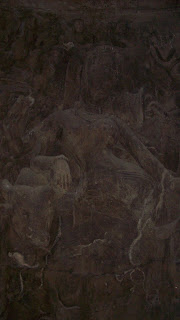Elephanta is the site of a 6th century Hindu cave temple, which, although not as impressive as the Ajanta or Ellora temples fills in the transition between the monumental architecture of late 5th temples and the almost baroque nature of the 8th century Dasavatara temple of Ellora. The architecture and sculpture is monumental, but the motifs are purely Hindu.
Our guide gave us a brief explanation of the Hindu philosophy, which might be interesting at this point: Hindus recognize the existence of a main deity with no name and no physical representation, who is referred to as "Tat" (this is a concept rather than a name). Because humans need to relate to the different aspects of "Tat", they have embodied "Tat" into the 330 million gods and godesses of their mythology. Hence, each god is just a part of the whole "Tat", so in venerating one god hear and another godess here they are simply approaching that part of "Tat" that is important for them at that particular moment. This is why their mythology is so complicated, and why a certain god takes so many forms.
Having talked about the millions of gods, there are three who form the upper echelon of their pantheon: Brama, the creator (of the universe and of all good things); Vishnu, the protector (of good things); and Shiva, the destroyer (of evil, but also of the universe so Brama can do his thing).
Elephanta is a temple complex devoted to Shiva (and to "Tat"), and its colossal sculptures 
The second focus of interest is an enormous bust with the three faces of Shiva. To the left is Shiva the destroyer of evil, with a stern masculine visage and holding a cobra in his hand. To the right is Shiva the creator (or Brama if I have not hopelessly confused the story), with a benign feminine visage and holding a lotus flower in her hand. Finally in the center is Shiva the protector (or Vishnu if I got it right), who looks over the people with a detached inscrutable face, but holding a pomegranate of abundance as a promise of abundance.



To make things even more confusing, enormous tableaux surround the grand hall of the temple, representing Shiva in further forms. In one he is dancing vigorously, waving furiously his eight arms to indicate the destruction of a former evil universe. In the next tableaux his dance has become more gentle, and with now only two arms he gently creates a new universe. In yet another tableaux he kills the evil remaining in the world by cutting its many heads and then collecting the blood in a vessel so it cannot sprout new heads (a story that reminds us of the killing of the hydra by the demi-god Hercules).

And to end this discourse I choose among the many others a tableaux in which Shiva appears in the guise of half woman (the right side) and half man (the left side) to show that the world arises from the union of its female and male counterparts.
Again, words cannot do justice to a a place imbued with spiritual and artistic richness. All I can say is that you must visit Elephanta if you ever come to India.
On the way back we had a fabulous look of the city, and that is my excuse to tell you a few words about the city of Bombay in the time of the British Raj. The Brits outdid themselves transforming a good but insalubrious bay into one of the grand cities of the Georgian age.Victoria railway station, the Prince of Wales museum (eventually the Prince of Wales was crowned King George), the university and its Big Ben tower, the grand avenues and parks, the race track, and the many administrative buildings gave the Bombay of the late 1800's the feeling of being a grand city second only to London.
Too bad that they couldn't keep dogs and Indians out of their great city! ("No dogs and Indians allowed" was in fact a common sign posted at the entrance of parks and buildings). And then 
The day was nicely rounded up by us breaking up into wandering groups to do some shopping and sightseeing (I ended getting lost and had to ask my way back to the hotel), followed by a delicious vegetarian meal at a busy, truly Indian restaurant (by that I mean a restaurant in which all the patrons but us were Indian). We had Tali, which is a tray where 10 or 12 small pots are set, and where the waiters keep serving all sorts of delicious dishes until you through the white towel to indicate that the food has defeated you. It was a great celebration of our last day in Incredible India!




1 comment:
Chennai, also known by its former English name Madras, was where i visited in India, and had some of the very same architectural and colonial flares. It was a challenge finding that which was truly unique to India, although the temples gave us a good idea of what indigenous India looked like. Colonial architecture is often so boring to look at as a tourist or art history connoisseur, but is of great importance to the inhabitants--they were very proud of those colonial buildings, mostly because they are now "old".
Post a Comment